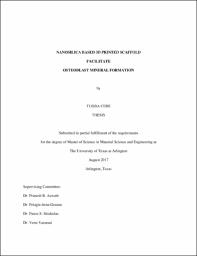
ATTENTION: The works hosted here are being migrated to a new repository that will consolidate resources, improve discoverability, and better show UTA's research impact on the global community. We will update authors as the migration progresses. Please see MavMatrix for more information.
Show simple item record
| dc.contributor.advisor | Aswath, Pranesh B. | |
| dc.contributor.advisor | Varanasi, Venu | |
| dc.creator | Cebe, Tugba | |
| dc.date.accessioned | 2019-08-29T18:16:19Z | |
| dc.date.available | 2019-08-29T18:16:19Z | |
| dc.date.created | 2017-08 | |
| dc.date.issued | 2017-08-24 | |
| dc.date.submitted | August 2017 | |
| dc.identifier.uri | http://hdl.handle.net/10106/28631 | |
| dc.description.abstract | Bone has the ability to heal fractures so long as the size of the fracture is sufficiently small. If the defect is large or of critical size, a filling material or graft will be needed to help bone union. Among all the available methods to address this medical condition, the common drawback of grafts is that they are limited in supply since a biological site or organism is needed to harvest the biological graft. As a new approach, researchers have been working with bioceramics and biopolymers for their use in bone tissue engineering. In this work, chitosan was modified with methacrylic anhydride. After the methacrylation process, methacrylated chitosan (MAC) was able to print a scaffold using a 3D printer (robocasting). Then, the MAC was integrated with laponite (MAC-Lp) and the printed scaffold in order to compare its properties with methacrylated gelatin (MAG) containing the laponite (MAG-Lp) scaffolds. Mechanical, dynamic mechanical and rheological properties were measured between MAC, MAC-Lp, MAG, and
xvii
MAG-Lp. We observed that the addition of laponite increased its viscosity, storage modulus, loss modulus and mechanical strength. Later, it was studied in vitro studies using MC3T3-E1 osteoblast precursor cell lines with MAC, MAC-Lp, MAG, MAG-Lp scaffolds and it was observed that MAC, MAC-Lp results in viability. Proliferation was greater than the MAG, MAG-Lp scaffolds. Finally, every scaffold was seeded for matrix deposition at 28 days and characterized with FTIR. Similarly to MAG and MAG-Lp scaffolds, the MAC and MAC-Lp scaffolds showed Amide I, III bands and additional phosphate bands. The highest ratio occurred in the MAC-Lp and MAC scaffolds. The MAC-Lp scaffolds were characterized with SEM to demonstrate fiber, and the SEM-EDS to show Ca and P atoms. The MAC-Lp scaffolds demonstrated collagen fiber, Ca and P atoms in the SEM. | |
| dc.format.mimetype | application/pdf | |
| dc.language.iso | en_US | |
| dc.subject | Gelatin | |
| dc.subject | Chitosan | |
| dc.subject | Scaffold | |
| dc.subject | 3D printing | |
| dc.subject | Bone | |
| dc.title | NANOSILICA BASED 3D PRINTED SCAFFOLD FACILITATE OSTEOBLAST MINERAL FORMATION | |
| dc.type | Thesis | |
| dc.degree.department | Materials Science and Engineering | |
| dc.degree.name | Master of Science in Materials Science and Engineering | |
| dc.date.updated | 2019-08-29T18:16:19Z | |
| thesis.degree.department | Materials Science and Engineering | |
| thesis.degree.grantor | The University of Texas at Arlington | |
| thesis.degree.level | Masters | |
| thesis.degree.name | Master of Science in Materials Science and Engineering | |
| dc.type.material | text | |
Files in this item
- Name:
- CEBE-THESIS-2017.pdf
- Size:
- 2.854Mb
- Format:
- PDF
This item appears in the following Collection(s)
Show simple item record


